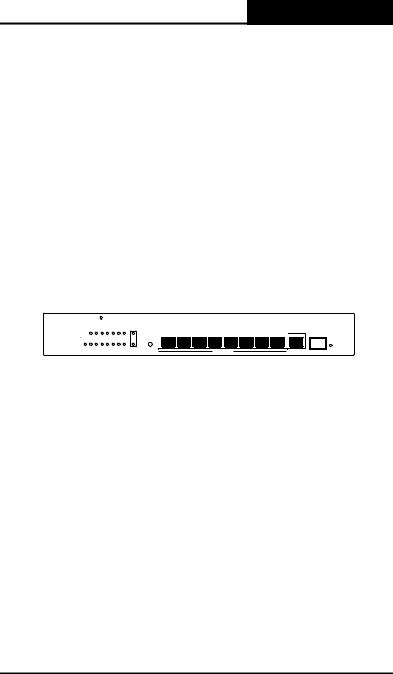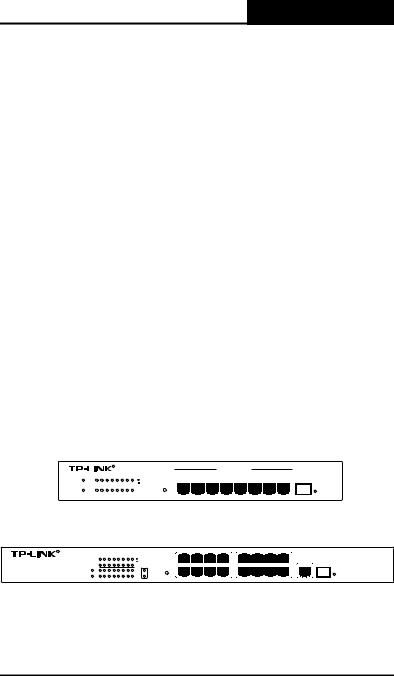Tp-link TL-SL2428WEB, TL-SL2452WEB, TL-SL2218WEB User Manual

User's Guide
TL-SG2109WEB
9-Port Gigabit Web Smart Switch
TL-SL2210WEB
8-Port 10/100Mbps + 2-Port Gigabit Web Smart Switch
TL-SL2218WEB
16-Port 10/100Mbps + 2-Port Gigabit Web Smart Switch
TLSL2428WEB
24-Port 10/100Mbps + 4-Port Gigabit Web Smart Switch
TL-SL2452WEB
48-Port 10/100Mbps + 4-Port Gigabit Web Smart Switch
Rev: 1.0.3
COPYRIGHT & TRADEMARKS
Specifications are subject to change without notice.  is a registered trademark of TP-LINK TECHNOLOGIES CO., LTD. Other brands and product names are trademarks or registered trademarks of their respective holders.
is a registered trademark of TP-LINK TECHNOLOGIES CO., LTD. Other brands and product names are trademarks or registered trademarks of their respective holders.
No part of the specifications may be reproduced in any form or by any means or used to make any derivative such as translation, transformation, or adaptation without permission from TP-LINK TECHNOLOGIES CO., LTD. Copyright © 2010 TP-LINK TECHNOLOGIES CO., LTD. All rights reserved.
FCC STATEMENT
This equipment has been tested and found to comply with the limits for a Class A digital device, pursuant to part 15 of the FCC Rules. These limits are designed to provide reasonable protection against harmful interference when the equipment is operated in a commercial environment. This equipment generates, uses, and can radiate radio frequency energy and, if not installed and used in accordance with the instruction manual, may cause harmful interference to radio communications. Operation of this equipment in a residential area is likely to cause harmful interference in which case the user will be required to correct the interference at his own expense.
This device complies with part 15 of the FCC Rules. Operation is subject to the following two conditions:
111 This device may not cause harmful interference.
222This device must accept any interference received, including interference that may cause undesired operation.

Any changes or modifications not expressly approved by the party responsible for compliance could void the user’s authority to operate the equipment.
EC DECLARATION OF CONFORMITY (EUROPE)
In compliance with the EMC Directive 89/336/EEC, Low Voltage Directive 73/23/EEC, this product meets the requirements of the following standards: ¾¾ EN55022
¾¾ EN55024
¾¾ EN60950
SAFETY NOTICES
Caution:
Do not use this product near water, for example, in a wet basement or near a swimming pool.
Avoid using this product during an electrical storm. There may be a remote risk of electric shock from lightning.
TABLE OF CONTENTS
Package contents.................................................................................. |
1 |
||
Chapter 1: Introduction........................................................................ |
2 |
||
1.1 |
Intended Audience................................................................................... |
2 |
|
1.2 |
Agreement............................................................................................... |
2 |
|
1.3 |
Guide Overview....................................................................................... |
2 |
|
Chapter 2: Device Description............................................................ |
4 |
||
2.1 |
Introduction to the Device........................................................................ |
4 |
|
2.2 |
Features and Technical Specifications ................................................... |
4 |
|
2.2.1 |
Features................................................................................................ |
4 |
|
2.2.2 |
Technical Specifications....................................................................... |
5 |
|
Chapter 3: Mounting Device............................................................... |
7 |
||
3.1 |
Install the Device..................................................................................... |
7 |
|
3.1.1 |
Desktop or Shelf Installation................................................................. |
7 |
|
3.1.2 |
Rack Installation................................................................................... |
7 |
|
3.1.3 AC Power ............................................................................................. |
8 |
||
3.2 |
Switch Aspect Description....................................................................... |
8 |
|
3.2.1 |
Front Panel........................................................................................... |
8 |
|
3.2.2 Back Panel.......................................................................................... |
10 |
||
3.2.3 SFP Module........................................................................................ |
10 |
||
3.3 |
Note....................................................................................................... |
11 |
|
Chapter 4: Function Description...................................................... |
12 |
||
4.1 System Setting...................................................................................... |
12 |
4.1.1 |
System Information............................................................................. |
12 |
||
4.1.2 |
File Transfer........................................................................................ |
12 |
||
4.1.3 Reboot & Reset.................................................................................. |
12 |
|||
4.1.4 User.................................................................................................... |
13 |
|||
4.2 |
Port Setting............................................................................................ |
13 |
||
4.2.1 Port Parameter................................................................................... |
13 |
|||
4.2.1.1 Duplex Mode................................................................................... |
13 |
|||
4.2.1.2 |
Flow Control.................................................................................... |
13 |
||
4.2.1.3 |
Port Security.................................................................................... |
13 |
||
4.2.2 |
Port Statistic and Port Status............................................................. |
14 |
||
4.2.3 |
Storm Control..................................................................................... |
14 |
||
4.2.4 |
Port Description.................................................................................. |
15 |
||
4.3 Network Setting..................................................................................... |
15 |
|||
4.3.1 Switch IP Address............................................................................... |
15 |
|||
4.3.2 Aging Time and Dynamic Address Table............................................ |
16 |
|||
4.3.3 Static MAC Address Table.................................................................. |
16 |
|||
4.3.4 Filtering MAC Address Table.............................................................. |
17 |
|||
4.3.5 Dynamic Binding................................................................................. |
17 |
|||
4.3.6 |
Ping..................................................................................................... |
18 |
||
4.4 VLAN Setting......................................................................................... |
18 |
|||
4.4.1 VLAN Mode ....................................................................................... |
19 |
|||
4.5 |
Port Trunking......................................................................................... |
20 |
||
4.6 |
Priority Setting....................................................................................... |
20 |
||
4.6.1 |
Priority Mode....................................................................................... |
20 |
||
4.6.2 |
Port-Based Priority............................................................................. |
21 |
||
4.6.3 |
Port Default Priority............................................................................ |
21 |
||
4.6.4 |
802.1p Priority..................................................................................... |
21 |
||
4.7 |
Port Mirroring......................................................................................... |
21 |
||
4.8 |
Virtual Cable Test................................................................................... |
22 |
||
Chapter 5: WEB Management.......................................................... |
23 |
|||
5.1 Overview................................................................................................ |
23 |
|||
5.2 Connecting to the Device...................................................................... |
23 |
|||
5.2.1 |
Getting Started .................................................................................. |
23 |
||
5.2.2 |
Login the Switch................................................................................. |
27 |
||
5.3 |
Setting the Device................................................................................. |
27 |
||
5.3.1 System Setting .................................................................................. |
32 |
|||
5.3.1.1 System Information ......................................................................... |
32 |
|||
5.3.1.2 |
File Transfer .................................................................................... |
33 |
||
5.3.1.3 Reboot & Reset............................................................................... |
34 |
|||
5.3.1.4 |
User................................................................................................. |
35 |
||
5.3.2 |
Port Setting......................................................................................... |
36 |
||
5.3.2.1 |
Port Parameter................................................................................ |
36 |
||
5.3.2.2 |
Port Statistic..................................................................................... |
37 |
||
5.3.2.3 |
Port Status....................................................................................... |
39 |
||
5.3.2.4 |
Storm Control.................................................................................. |
40 |
||
5.3.2.5 |
Port Description............................................................................... |
41 |
||
5.3.3 |
Network Setting.................................................................................. |
41 |
||
5.3.3.1 Switch IP Address............................................................................ |
42 |
|||
5.3.3.2 Static MAC Address........................................................................ |
43 |
|||
5.3.3.3 |
Filtering MAC Address..................................................................... |
45 |
||
5.3.3.4 Dynamic Binding.............................................................................. |
46 |
|||
5.3.3.5 Bound MAC Address....................................................................... |
48 |
|||
5.3.3.6 Aging Time ...................................................................................... |
49 |
||
5.3.3.7 |
Ping.................................................................................................. |
50 |
|
5.3.4 VLAN Setting...................................................................................... |
51 |
||
5.3.4.1 VLAN Mode..................................................................................... |
51 |
||
5.3.4.2 Port VLAN Setting........................................................................... |
51 |
||
5.3.4.3 Tag VLAN Global Setting................................................................. |
53 |
||
5.3.4.4 Tag VLAN Setting............................................................................ |
54 |
||
5.3.4.5 MTU VLAN Setting.......................................................................... |
56 |
||
5.3.5 |
Port Trunking...................................................................................... |
56 |
|
5.3.6 |
Priority Setting.................................................................................... |
57 |
|
5.3.6.1 |
Priority Mode................................................................................... |
58 |
|
5.3.6.2 |
Port-Based Priority.......................................................................... |
58 |
|
5.3.6.3 |
Port Default Priority......................................................................... |
59 |
|
5.3.6.4 |
802.1p Priority Class....................................................................... |
59 |
|
5.3.7 |
Port Mirroring...................................................................................... |
60 |
|
5.3.8 |
Virtual Cable Test................................................................................ |
61 |
|
Appendix A Pin Explain For RJ-45 Connector............................... |
63 |
||
Appendix B Table of Factory Defaults............................................. |
65 |
||
Appendix C Table of Function Differences of Switch Family ..... |
67 |
||

TL-SG2109WEB/TL-SL2210WEB/TL-SL2218WEB/TL-SL2428WEB/TL-SL2452WEB Gigabit Web Smart Switch User's Guide
Package contents
The following contents should be found in your box: ¾¾ One Web Smart Switch
¾¾ One AC power cord ¾¾ User Guide
¾¾ Two mounting brackets and other fittings
Note:
If any of the listed contents are damaged or missing, please contact the retailer from whom you purchased the TL-SG2109WEB/TL-SL2210WEB/TL- SL2218WEB/TL-SL2428WEB/TL-SL2452WEB Gigabit Web Smart Switch for assistance.
1

TL-SG2109WEB/TL-SL2210WEB/TL-SL2218WEB/TL-SL2428WEB/TL-SL2452WEB Gigabit Web Smart Switch User's Guide
Chapter 1: Introduction
Thanks for choosing the TL-SG2109WEB/TL-SL2210WEB/TL-SL2218WEB/ TL-SL2428WEB/TL-SL2452WEB Gigabit Web Smart Switch! The switch family provides friendly management interface and excellent performance.
1.1 Intended Audience
This guide is intended for network administrators familiar with IT concepts and network terminology.
1.2 Agreement
Due to the similarity in function of the TL-SG2109WEB/TL-SL2210WEB/TL- SL2218WEB/TL-SL2428WEB/TL-SL2452WEB Gigabit Web Smart Switch, the TL-SL2210WEB model is selected to illustrate the usage of this switch family. The “switch” referred in this guide indicates the TL-SG2109WEB/TL- SL2210WEB/TL-SL2218WEB/TL-SL2428WEB/ TL-SL2452WEB Gigabit Web Smart Switch.
1.3 Guide Overview
This user guide is divided into the following sections to provide concise information for configuring, and managing the TP-Link device:
Section 1: Introduction.
Section 2: Device Description -- Provides an overview about the switch family. Section 3: Mounting Device -- Describes the mounting procedure of the switch.
Section 4: Function Description -- Describes the functions supported by the switch family and presents the network concepts referred in this guide.
2

TL-SG2109WEB/TL-SL2210WEB/TL-SL2218WEB/TL-SL2428WEB/TL-SL2452WEB Gigabit Web Smart Switch User's Guide
Section 5: WEB Management -- Give an explanation to the terms in WEB interface and describes the configuring suggestions of the switch.
Appendix A: Pin Explain For RJ-45 Connector Appendix B: Table of Factory Defaults
Appendix C: Table of Function Differences of Switch Family
3

TL-SG2109WEB/TL-SL2210WEB/TL-SL2218WEB/TL-SL2428WEB/TL-SL2452WEB Gigabit Web Smart Switch User's Guide
Chapter 2: Device Description
2.1 Introduction to the Device
TheTL-SG2109WEB/TL-SL2210WEB/TL-SL2218WEB/TL-SL2428WEB/ TL-SL2452WEB Gigabit Web Smart Switch is compliant with the IEEE802.3
Ethernet protocols. The EIA-standardized framework and smart configuration capacity can provide flexible solutions for variable scale of networks.
This switch family is equipped with powerful management interface, via which system, port, network, VLAN, truck and priority can be configured.
TheTL-SG2109WEB/TL-SL2210WEB/TL-SL2218WEB/TL-SL2428WEB/TL- SL2452WEB Gigabit Web Smart Switch provides 0/8/16/24/48 10/100M Fast Ethernet ports, 8/1/1/2/2 10/100/1000M Gigabit Ethernet ports and 1/1/1/2/2 SFP ports respectively, which extends the connecting area and increases the networking flexibility.
2.2 Features and Technical Specifications
2.2.1 Features
¾¾ Compliant with IEEE802.3, IEEE802.3u, IEEE802.3ab and IEEE802.3z Standards
¾¾ IEEE 802.3x flow control for full-duplex ¾¾ Back pressure flow control for half-duplex
¾¾ Store-and-Forward switching method
¾¾ (0/8/16/24/48) 10/100BASE-TX Fast Ethernet ports (Auto MDI/MDI-X support)
¾¾ (8/1/1/2/2) 1000BASE-T Gigabit Ethernet ports (Auto MDI/MDI-X support) ¾¾ (1/1/1/2/2) SFP ports
4

|
TL-SG2109WEB/TL-SL2210WEB/TL-SL2218WEB/TL-SL2428WEB/TL-SL2452WEB |
Gigabit Web Smart Switch User's Guide |
¾¾ Support N-Way adaptive mode |
||
¾¾ |
Support up 200 meters of Cat. 5 cables at the transmission speed of 10M |
|
¾¾ |
Support MAC address table of 8K entries |
|
¾¾ Support MAC address learning and aging time
¾¾ Support port-based VLAN and IEEE802.1Q tag VLAN ¾¾ Support trunks
¾¾ Support management via WEB browser
¾¾ Support port-based priority and IEEE 802.1p priority
¾¾ Support static MAC address and filtering MAC address
¾¾ Support dynamic binding of MAC address
¾¾ Support port security, storm control and port monitoring ¾¾ Support virtual cable test
¾¾ Support static switch IP address and dynamic switch IP address through DHCP client
¾¾ Support system upgrading, configuration uploading and backup through
TFTP server
2.2.2 Technical Specifications
|
IEEE802.3 10Base-T Ethernet |
|
|
IEEE802.3u 100Base-TX Fast Ethernet |
|
|
|
|
Standards |
IEEE802.3ab 1000Base-T Gigabit Ethernet |
|
|
|
|
|
IEEE802.3z 1000Base-X Gigabit Ethernet |
|
|
|
|
|
IEEE802.3x Flow Control |
|
|
|
|
Port |
RJ-45 ports, which support MDI/MDIX, and some SFP ports are |
|
provided (Appendix C can be referred for details) |
||
|
||
|
IEEE802.1Q Tag VLAN Mode |
|
VLAN Mode |
Port-based VLAN Mode |
|
|
|
|
|
MTU VLAN Mode |
|
|
|
5

TL-SG2109WEB/TL-SL2210WEB/TL-SL2218WEB/TL-SL2428WEB/TL-SL2452WEB Gigabit Web Smart Switch User's Guide
Transmission |
|
10Base-T: UTP/STP of Cat. 3 or above |
|
|
|
||
|
100Base-TX: UTP/STP of Cat. 5 |
||
Medium |
|
||
|
1000Base-X: MMF or SMF SFP Module (OPTIONAL) |
||
|
|
||
|
|
|
|
|
Power |
Indicates whether power is supplied or not |
|
|
|
|
|
LED |
|
10/100Mbps RJ-45 port: Link/Act LED and 10/100Mbps LED |
|
Port |
|
||
10/100/ 1000Mbps RJ-45 port: Link/Act and 10/100/1000Mbps LED |
|||
|
|||
|
|
|
|
|
|
SFP port: 1000Mbps Link/Act LED |
|
|
|
|
|
|
|
294mm×180mm×44mm (TL-SG2109WEB/TL-SL2210WEB) |
|
Dimensions |
|
|
|
|
440mm×180mm×44mm (TL-SL2218WEB) |
||
|
|
|
|
(L×W×H) |
|
440mm×220mm×44mm (TL-SL2428WEB) |
|
|
|
440mm×260mm×44mm (TL-SL2452WEB) |
|
|
|
Operating Temperature: 0OC ~ 40OC |
|
Operating |
|
Storage Temperature: -40OC ~ 70OC |
|
Environment |
|
Operating Humidity: 10% ~ 90% RH |
|
|
|
Storage Humidity: 5% ~ 90% RH |
|
|
|
|
|
Power Supply |
|
AC 100-240V~ 50-60Hz |
|
|
|
|
6

TL-SG2109WEB/TL-SL2210WEB/TL-SL2218WEB/TL-SL2428WEB/TL-SL2452WEB Gigabit Web Smart Switch User's Guide
Chapter 3: Mounting Device
3.1 Install the Device
Installation Precautions:
1.Ensure the surface on which the device is placed is adequately secured to prevent it from becoming unstable and/or falling over.
2.Ensure the power outlet is placed within 1.5 m (5 feet) of the device.
3.Ensure the device is connected safely to the power outlet with the AC power cable.
4.Ensure the device is placed in a ventilated enviroment.
3.1.1 |
Desktop or Shelf Installation |
|
1. |
Place the switch on the desktop with its bottom upturned. |
|
2. |
Attach the supplied rubber feet on the bottom at each corner of the switch. |
|
3. |
Turnover the switch and place it on the desktop. |
|
3.1.2 |
Rack Installation |
|
The device can be mounted in an EIA standard-sized, 19-inch rack, which can be placed in a wiring closet with other equipment.
1.Install the supplied rack-mounting bracket on each side of the device, using the supplied screws. The following figure illustrates where to mount the brackets.
Power
System
Act |
|
|
|
|
TL- |
SL2210WEB |
|
|
|
||
Link |
|
|
|
|
|
|
|
|
|
|
|
100M |
1 |
2 |
3 |
4 |
5 6 |
|
|
|
8+2G |
Web- |
Smart Switch |
|
|
|
|
7 8 |
|
Link/Act |
1 |
|
|||
|
|
|
|
|
|
|
|
1000M |
|
|
|
|
|
|
|
|
|
|
GIGA |
RESET |
|
|
|
GIGA |
SFP |
|
|
10/100/1000Mbps |
1000Mbps |
|
Link/Act
Figure 3-1 Mounting Brackets
7

TL-SG2109WEB/TL-SL2210WEB/TL-SL2218WEB/TL-SL2428WEB/TL-SL2452WEB Gigabit Web Smart Switch User's Guide
2.Insert the switch into the rack.
3.Fix the switch to the rack with the rack screws (not provided).
3.1.3 AC Power
The switch can be used with AC power supply 100 to 240V AC,50 to 60Hz. The switch’s power supply will adjust to the local power source automatically. The electrical outlet shall be installed near the device and shall be easily accessible.
3.2 Switch Aspect Description
3.2.1 Front Panel
The front panel of TL-SL2210WEB is configured as follows:
 R TL-SL2210WEB 8+2G Web-Smart Switch
R TL-SL2210WEB 8+2G Web-Smart Switch
Power  Link
Link 

Act |
1 |
2 |
|
System  100M
100M
|
|
|
|
|
|
1 |
2 |
3 |
4 |
5 |
6 |
7 |
8 |
GIGA |
SFP |
|
|
|
|
|
|
Link/Act |
|
|
|
|
|
|
|
|
|
3 |
4 |
5 |
6 |
7 |
8 |
|
|
|
|
|
|
|
|
|
|
|
|
|
|
|
|
1000M |
|
|
|
|
|
|
|
|
Link/Act |
|
|
|
|
|
GIGA |
RESET |
|
|
10/100Mbps |
|
|
|
10/100/1000Mbps |
1000Mbps |
|
Figure 3-2. TL-SL2210WEB Front Panel
¾¾ 8 10/100Mbps RJ-45 ports: designed to connect to the device with the bandwidth of 10M or 100M.Each port has a corresponding Link/Act and 10/100Mbps LED.
¾¾ 1 10/100/1000Mbps RJ-45 ports: designed to connect to the device with the bandwidth of 10M, 100M or 1000M. It has a corresponding Link/Act and 10/100/1000Mbps LED.
¾¾ 1 SFP ports: designed to install SFP module. It has a corresponding 1000Mbps Link/Act LED.
¾¾ Reset Button: Press this button for three seconds to the reset software setting back to factory default setting.
8

TL-SG2109WEB/TL-SL2210WEB/TL-SL2218WEB/TL-SL2428WEB/TL-SL2452WEB Gigabit Web Smart Switch User's Guide
¾¾ LEDS
1)LEDs lie at the left side of the panel (1000Mbps Link/Act LED of the SFP lie at right side of the SFP).
2)Power LED: solid red when power is supplied to the switch and is operating normally.
3)System LED: solid green when CPU of the switch works normally.
4)10/100Mbps LED: When a 10/100Mbps port connect to a 100Mbps device, the corresponding LED turns on in solid green; When the port connects to a 10Mbps device, the LED turns off.
5)10/100/1000Mbps LED: When a 10/100/1000Mbps port connect to a 1000Mbps device, the corresponding LED turns on in solid green; When the port connect to a 10/100Mbps device, the LED turns off.
6)Link/Act LED: Solid green when a valid link is established on the port; Flashes green when packet transmission or reception is occurring on the port. (SFP port has Link/Act LED only and must connect to 1000Mbps device.)
The following shows the front panel of TL-SG2109WEB, TL-SL2218WEB, TLSL2428WEB and TL-SL2452WEB:
|
|
|
R |
|
TL-SG2109WEB |
|
|
|
10/100/1000Mbps |
|
|
1000Mbps |
||||
|
|
|
|
|
|
|
|
|
1 |
2 |
3 |
4 |
5 |
6 |
7 |
8 |
Power |
|
|
|
|
|
|
|
Link |
|
|
|
|
|
|
|
SFP |
1 |
2 |
3 |
4 |
5 |
6 |
7 |
8 |
Act |
RESET |
|
|
|
|
|
|
|
|
|
|
|
|
|
|
|
|||||||||
System |
|
|
|
|
|
|
|
1000M |
|
|
|
|
|
|
|
Link/Act |
8+1 Gigabit Web-Smart Switch |
|
|
|
|
|
|
|
|
|
|
|
|||||
Figure 3-3 TL-SG2109WEB Front Panel |
||||||||||||||||
R |
|
|
|
|
|
|
|
|
1 |
3 |
5 |
7 |
9 |
11 |
13 |
15 |
TL-SL2218WEB |
|
|
|
|
|
|
|
|
Link |
|
|
|
|
|
|
|
GIGA |
1 |
3 |
5 |
7 |
9 |
11 |
13 |
15 |
Act |
|
|
|
|
|
|
|
||
|
|
|
|
|
|
|
|
100Mbps |
RESET |
|
|
|
|
|
|
SFP |
|
|
|
|
|
|
|
|
|
|
|
|
|
|
|
|
|
|
|
|
Power |
|
|
|
|
|
|
|
|
Link/Act |
|
|
|
|
|
|
|
16+2G Gigabit Web-Smart Switch |
2 |
4 |
6 |
8 |
10 |
12 |
14 |
16 |
GIGA |
|
|
|
|
|
|
|
Link/Act |
System |
|
|
|
|
|
|
|
|
1000Mbps |
|
|
|
|
|
|
|
|
|
|
|
|
|
|
|
|
|
|
2 |
4 |
6 |
8 |
10 |
12 |
14 |
16 |
Figure 3-4 TL-SL2218WEB Front Panel
9

TL-SG2109WEB/TL-SL2210WEB/TL-SL2218WEB/TL-SL2428WEB/TL-SL2452WEB Gigabit Web Smart Switch User's Guide
Power
|
1 |
3 |
5 |
7 |
9 |
11 |
13 |
15 |
17 |
19 |
21 |
23 |
GIGA1 |
TL-SL2428WEB |
Link Act |
|
6 |
8 |
10 |
|
|
16 |
18 |
20 |
|
|
GIGA2 |
|
2 |
4 |
12 |
14 |
22 |
24 |
|||||||
24+4G Gigabit Web-Smart Switch |
System |
|
|
|
|
100M |
|
|
|
|
|
1000M |
|
|
|
|
|
|
|
|
|
|
|
|
|||
1 |
3 |
5 |
7 |
9 |
11 |
13 |
15 |
17 |
19 |
21 |
23 |
GIGA1 |
|
|
|
|
|
|
|
|
|
|
|
|
SFP 1 |
SFP 2 |
SFP 1 |
|
|
|
|
|
|
|
|
|
|
|
|
|
|
Reset |
2 |
4 |
6 |
8 |
10 |
12 |
14 |
16 |
18 |
20 |
22 |
24 |
GIGA2 |
|
SFP 2 |
|
|
Figure 3-5 TL-SL2428WEB Front Panel
1 |
2 |
3 |
4 |
5 |
6 |
7 |
8 |
9 |
10 |
11 |
12 |
13 |
14 |
15 |
16 |
17 |
18 |
19 |
20 |
21 |
22 |
23 |
24 |
25 |
26 |
27 |
28 |
29 |
30 |
31 |
32 |
33 |
34 |
35 |
36 |
37 |
38 |
39 |
40 |
41 |
42 |
43 |
44 |
45 |
46 |
47 |
48 |
GIGA1 GIGA2 |
|
1 |
|
3 |
5 |
|
7 |
|
9 |
|
|
11 |
13 |
|
|
15 |
17 |
|
19 |
|
|
21 |
23 |
|
|
25 |
27 |
|
|
29 |
|
31 |
33 |
|
|
35 |
37 |
|
39 |
|
|
41 |
|
43 |
|
45 |
|
47 |
GIGA1 |
Power |
|
|
|
|
|
|
|
|
|
|
|
|
|
|
|
|
|
|
|
|
|
|
|
|
|
|
|
|
|
|
|
|
|
|
|
|
|
|
|
|
|
|
|
|
|
|
|
|
RESET |
|
|
|
|
|
|
|
|
|
|
|
|
|
|
|
|
|
|
|
|
|
|
|
|
|
|
|
|
|
|
|
|
|
|
|
|
|
|
|
|
|
|
|
|
|
|
|
|
System |
|
|
|
|
|
|
|
|
|
|
|
|
|
|
|
|
|
|
|
|
|
|
|
|
|
|
|
|
|
|
|
|
|
|
|
|
|
|
|
|
|
|
|
|
|
|
|
|
|
2 |
|
4 |
6 |
|
8 |
|
10 |
|
|
12 |
14 |
|
|
16 |
18 |
|
20 |
|
|
22 |
24 |
|
|
26 |
28 |
|
|
30 |
|
32 |
34 |
|
|
36 |
38 |
|
40 |
|
|
42 |
|
44 |
|
46 |
|
48 |
GIGA2 |
 R
R
TL-SL2452WEB
48+4G Gigabit Web-Smart Switch
SFP 1 |
SFP 2 |
Link/Act |
SFP 1
SFP 2
Figure 3-6 TL-SL2452WEB Front Panel
3.2.2 Back Panel
The back panel of the switch is configured as follows:
Figure 3-7 TL-SG2109WEB/SL2210WEB Back Panel
Figure 3-9 TL-SL2218WEB/SL2428WEB/SL2452WEB Back Panel
¾¾ AC Power Connector: This is a three-pronged connector that supports the power cable. Plug in the female connector of the provided power cable into this connector, and the male into a power outlet.
3.2.3 SFP Module
The SFP port accommodates a standard SFP module. Small Form Factor Pluggable (SFP) Optical Show as follow.
10

TL-SG2109WEB/TL-SL2210WEB/TL-SL2218WEB/TL-SL2428WEB/TL-SL2452WEB Gigabit Web Smart Switch User's Guide
SFP module support hot-plugging, plug the SFP module into the SFP port and the switch can identify it automatically.
3.3 Note
¾¾ The surface on which the switch is placed should be adequately secured to prevent it from becoming unstable and/or falling over.
¾¾ Ensure the power source circuits are properly grounded.
¾¾ Ensure the power cable, extension cable, and/or plug is not damaged. ¾¾ Ensure the switch is not exposed to water.
¾¾ Ensure the switch is not exposed to radiators and/or heat sources.
¾¾ Do not push foreign objects into the switch, as it may cause a fire or electric shock.
¾¾ Allow the switch to cool before removing covers or touching internal equipment.
¾¾ Use the switch only with approved equipment. If the switch is connected to other network devices with UTP cable, ensure that the cable is not more than 100 meters .
11

TL-SG2109WEB/TL-SL2210WEB/TL-SL2218WEB/TL-SL2428WEB/TL-SL2452WEB Gigabit Web Smart Switch User's Guide
Chapter 4: Function Description
This section presents the network concepts referred in switch function description.
4.1 System Setting
System setting contains the following topics: displaying and configuring the switch information, upgrading firmware, backing up and loading configuration, rebooting and soft-resetting, configuring username and password.
4.1.1 System Information
The system information contains hardware version, software version, system description, system name, system location, contact information and run time.
4.1.2 File Transfer
TL-SG2109WEB/TL-SL2210WEB/TL-SL2218WEB/TL-SL2428WEB/TL- SL2452WEB Gigabit Web Smart Switch is equipped with the function of configuration backup, configuration loading and system upgrading.
The configuration file and executive file are transferred in TFTP protocol.
TFTP (Trivial File Transfer Protocol) is dedicated to transferring files between two network stations. It’s based on UDP protocol.
4.1.3 Reboot & Reset
The “Reset” indicates “Soft-reset” here. Soft-resetting restores the switch configuration to default except the switch IP address.
12

TL-SG2109WEB/TL-SL2210WEB/TL-SL2218WEB/TL-SL2428WEB/TL-SL2452WEB Gigabit Web Smart Switch User's Guide
4.1.4 User
The username and password can be modified in order to exclude illegal users.
4.2 Port Setting
4.2.1 Port Parameter
4.2.1.1 Duplex Mode
Ports have the duplex modes: 10M HD, 10M FD, 100M HD, 100M FD and 1000M FD (Giga port support).
The First part indicates the transmission rate and the second part indicates the duplex mode.
¾¾ HD: half-duplex, the port supports transmission between the device and the client in only one direction at a time.
¾¾ FD: full-duplex, the port supports transmission between the device and its link partner in both directions simultaneously.
Switch support auto negotiation is a protocol between two link partners that enables a port to advertise its transmission rate and duplex mode to its partner.
4.2.1.2 Flow Control
Flow control enables lower speed devices to communicate with higher speed devices. This is implemented by the higher speed device refraining from sending packets.
4.2.1.3 Port Security
13

TL-SG2109WEB/TL-SL2210WEB/TL-SL2218WEB/TL-SL2428WEB/TL-SL2452WEB Gigabit Web Smart Switch User's Guide
If the port security is enabled, it will not learn new MAC address and only transmit the frames from the MAC address list in the port’s static MAC address table.
4.2.2 Port Statistic and Port Status
Port Statistic calculates the statistics of each port, such as how many frames, error frames, broadcast frames it has received, and so on.
Port Status indicates whether the port is linked, not linked or disabled, what speed and duplex mode it is working on, and whether flow control is enabled or disabled.
4.2.3 Storm Control
Storm control limits the amount of multicast, broadcast and UL (the address hasn't been learned) frames accepted and forwarded by the device. When
Layer 2 frames are forwarded, broadcast, multicast and UL frames are flooded to all ports on the relevant VLAN. This occupies bandwidth, and loads all nodes on all ports.
A Storm is a result of an excessive amount of these frames simultaneously transmitted across a network by a single port. Forwarded message responses are heaped onto the network, straining network resources or causing the network to time out. Storm control is enabled for all ports by defining the packet type and the rate at which the packets are transmitted. The system measures the incoming defined frame rates on each port, and discards the frames when the rate exceeds a user-defined rate.
14

TL-SG2109WEB/TL-SL2210WEB/TL-SL2218WEB/TL-SL2428WEB/TL-SL2452WEB Gigabit Web Smart Switch User's Guide
4.2.4 Port Description
Use a description word to indicate the port.
4.3 Network Setting
The network module provides the function of setting switch IP address, dynamic binding and aging time, configuring static MAC address and filtering
MAC address, displaying dynamic bound address and ping.
4.3.1 Switch IP Address
An IP address is indispensable for a switch to be accessed. TheTL- SG2109WEB/TL-SL2210WEB/TL-SL2218WEB/TL-SL2428WEB/TL-
SL2452WEB Gigabit Web Smart Switch provides the configuration interface of IP address, netmask and default gateway.
DHCP (Dynamic Host Configuration Protocol) is dedicated for the DHCP client to obtain IP configuration information from the DHCP server. Two types of information are included in IP configuration information. One type is specific configuration information; another is IP address parameter. DHCP is based on client-server mode. The network station that offers the IP configuration information is called DHCP server.
Make sure that a DHCP server is correctly connected to the network, enable the DHCP client function of the switch, then the switch will automatically obtain IP address, netmask and default gateway from the DHCP server.
If more than one DHCP servers are available in the network, the switch will choose one according to a specific algorithm.
15

TL-SG2109WEB/TL-SL2210WEB/TL-SL2218WEB/TL-SL2428WEB/TL-SL2452WEB Gigabit Web Smart Switch User's Guide
Notice:
If no DHCP server is present in the network, the DHCP client fails to get IP configuration information, the switch then restores the IP parameters to default in several minutes to ensure a valid IP address being equipped.
4.3.2 Aging Time and Dynamic Address Table
A dynamic MAC address table is maintained inside the switch. A MAC address is the physical address of a network device; it is six-bytes long and should be hole in a subnet.Anetwork device can be identified by its MAC address.
A dynamic address table entry contains two items: MAC address and its corresponding switch port. The dynamic address table is volatile. The dynamic address entry begins to age once it has been added; it will be purged if it isn’t renewed in a specified length of time, which is defined as aging time.
The aging time ranges from 0 to 3825 seconds for this switch family.
The default value is 300 seconds. Dynamic address table entry won’t age if 0 is set. The aging time precision is 15 seconds.
4.3.3 Static MAC Address Table
A static MAC address table entry contains a MAC address and its corresponding switch port. All the packets taking that MAC address as their destination will be forwarded to the corresponding switch port.
The static MAC address won’t age, which differs from the dynamic MAC address. The static MAC address table entry is always valid before it is deleted.
16
